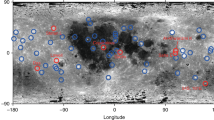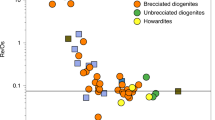Abstract
The Moon experienced an intense period of impacts about 4 Gyr ago. This cataclysm is thought to have affected the entire inner Solar System and has been constrained by the radiometric dating of lunar samples: 40Ar–39Ar ages reflect the heating and degassing of target rocks by large basin-forming impacts on the Moon. Radiometric dating of meteorites from Vesta and the H-chondrite parent body also shows numerous 40Ar–39Ar ages between 3.4 and 4.1 Gyr ago, despite a different dynamical context, where impacts typically occur at velocities too low to reset geochronometers. Here we interpret the 40Ar–39Ar age record in meteorites to reflect unusually high impact velocities exceeding 10 km s−1. Compared with typical impact velocities for main-belt asteroids of about 5 km s−1, these collisions would produce 100–1,000 times more highly heated material by volume. We propose that the 40Ar–39Ar ages between 3.4 and 4.1 Gyr ago from Vesta, the H-chondrite parent body and the Moon record impacts from numerous main-belt asteroids that were driven onto high-velocity and highly eccentric orbits by the effects of the late migration of the giant planets. We suggest that the bombardment persisted for many hundreds of millions of years and affected most inner Solar System bodies.
This is a preview of subscription content, access via your institution
Access options
Subscribe to this journal
Receive 12 print issues and online access
$259.00 per year
only $21.58 per issue
Buy this article
- Purchase on Springer Link
- Instant access to full article PDF
Prices may be subject to local taxes which are calculated during checkout




Similar content being viewed by others
Change history
24 March 2013
In the print version of this Article, in the 7th author affiliation the US state is incorrect; it should read 'Arizona'. The 'accepted' date of the Article is also incorrect; it should read 8 February 2013. These errors are correct in the HTML and PDF versions.
References
Kring, D. A. & Cohen, B. A. Cataclysmic bombardment throughout the inner solar system 3.9–4.0 Gyr. J. Geophys. Res. 107, 4–1 (2002).
Bogard, D. D. K-Ar ages of meteorites: clues to parent-body thermal histories. Chem. Erde Geochem. 71, 207–226 (2011).
Swindle, T. D. et al. in 40Ar–30Ar Dating: From Geochronology to Thermochronology, from Archaeology to Planetary Sciences (eds Jourdan, F., Mark, D. & Verati, C.) (The Geological Society, in the press, 2012).
Cohen, B. A., Swindle, T. D. & Kring, D. A. Support for the lunar cataclysm hypothesis from lunar meteorite impact melt ages. Science 290, 1754–1756 (2000).
Bogard, D. D. Impact ages of meteorites: A synthesis. Meteoritics 30, 244–268 (1995).
Tera, F., Papanastassiou, D. A. & Wasserburg, G. J. Isotopic evidence for a terminal lunar cataclysm. Earth Planet. Sci. Lett. 22, 1–21 (1974).
Turner, G., Cadogan, P. H. & Yonge, C. J. Proc. Fourth Lunar Sci. Conf. 1889–1914 (1973).
Stöffler, D. & Ryder, G. Stratigraphy and isotope ages of lunar geologic units: Chronological standard for the inner Solar System. Space Sci. Rev. 96, 9–54 (2001).
Grange, M. L., Nemchin, A. A., Timms, N., Pidgeon, R. T. & Meyer, C. Complex magmatic and impact history before 4.1 Gyr recorded in zircon from Apollo 17 South Massif aphanitic breccia 73235. Geochim. Cosmochim. Acta 75, 2213–2232 (2011).
Norman, M. D., Duncan, R. A. & Huard, J. J. Imbrium provenance for the Apollo 16 Descartes terrain: argon ages and geochemistry of lunar breccias 67016 and 67455. Geochim. Cosmochim. Acta 74, 763–783 (2010).
Neukum, G. & Ivanov, B. A. in Hazards Due to Comets and Asteroids (eds Gehrels, Tom, Matthews, M. S. & Schumann, A.) (Space Science Series, Univ. Arizona Press, p. 359 (1994).
Bottke, W. F. et al. An Archaean heavy bombardment from a destabilized extension of the asteroid belt. Nature 485, 78–81 (2012).
Bottke, W. F., Levison, H. F., Nesvorny, D. & Dones, L. Can planetesimals left over from terrestrial planet formation produce the lunar Late Heavy Bombardment? Icarus 190, 203–223 (2007).
Chapman, C. R., Cohen, B. A. & Grinspoon, D. H. What are the real constraints on the existence and magnitude of the late heavy bombardment? Icarus 189, 233–245 (2007).
Marchi, S., Bottke, W. B., Kring, D. A. & Morbidelli, A. The onset of the lunar cataclysm as recorded in its ancient crater populations. Earth Planet. Sci. Lett. 325–326, 27–38 (2012).
Morbidelli, A., Marchi, S., Bottke, W. F. & Kring, D. A. A sawtooth-like timeline for the first billion years of lunar bombardment. Earth Planet. Sci. Lett. 355–356, 144–151 (2012).
Consolmagno, G. Y. & Drake, M. J Composition and evolution of the eucrite parent body- Evidence from rare earth elements. Geochim Cosmochim. Acta 41, 1271–1282 (1977).
McSween, H. Y. et al. HED meteorites and their relationship to the geology of vesta and the dawn mission. Space Sci. Rev. 163, 141–174 (2011).
De Sanctis, M. C. et al. Spectroscopic characterization of mineralogy and its diversity across vesta. Science 336, 697–700 (2012).
Russell, C. T. et al. Dawn at vesta: Testing the protoplanetary paradigm. Science 336, 684–686 (2012).
Harrison, K. P. & Grimm, R. E. Thermal constraints on the early history of the H-chondrite parent body reconsidered. Geochim. Cosmochim. Acta 74, 5410–5423 (2010).
Bottke, W. F., Vokrouhlicky, D., Rubincam, D. P. & Nesvorny, D. The Yarkovsky and YORP effects: Implications for asteroid dynamics. Annu. Rev. Earth Planet. Sci. 34, 157–191 (2006).
Bogard, D. D. & Garrison, D. H. 39Ar–40Ar ages of eucrites and thermal history of asteroid 4 Vesta. Meteorit. Planet. Sci. 38, 669–710 (2003).
Morbidelli, A., Brasser, R., Gomes, R., Levison, H. F. & Tsiganis, K. Evidence from the asteroid belt for a violent past evolution of Jupiter’s orbit. Astron. J. 140, 1391–1401 (2010).
Minton, D. A. & Malhotra, R. Dynamical erosion of the asteroid belt and implications for large impacts in the inner Solar System. Icarus 207, 744–757 (2010).
Davis, D. R., Chapman, C. R., Weidenschilling, S. J. & Greenberg, R. Collisional history of asteroids: evidence from Vesta and the Hirayama families. Icarus 63, 30–53 (1985).
O’Brien, D. P., Morbidelli, A. & Bottke, W. F. The primordial excitation and clearing of the asteroid belt-Revisited. Icarus 191, 434–452 (2007).
Bottke, W. F., Nolan, M. C., Greenberg, R. & Kolvoord, R. A. Velocity distributions among colliding asteroids. Icarus 107, 255–268 (1994).
Cohen, B. A. The Vestal cataclysm: Impact-melt clasts in howardites and the bombardment history of 4 Vesta. Meteorit. Planet. Sci. (in the press, 2012).
Ivanov, B. A. Heating of the lithosphere during meteorite cratering. Solar Syst. Res. 38, 266–278 (2004).
Keil, K., Stoeffler, D., Love, S. G. & Scott, E. R. D. Constraints on the role of impact heating and melting in asteroids. Meteoritics 32, 349–363 (1997).
Pierazzo, E., Vickery, A. M. & Melosh, H. J. A reevaluation of impact melt production. Icarus 127, 408–423 (1997).
Ivanov, B. A. & Artemieva, N. A. Numerical modelling of the formation of large impact craters. GSA Special Paper 356, 619–630 (2002).
Mittlefehldt, D. W., McCoy, T. J., Goodrich, C. A. & Kracher, A. in Planetary Materials (ed. Papike, James J.) Chapter 4, 4-001–4-196 (Reviews in Mineralogy, Vol. 36, Mineralogical Society of America, 1998).
Schenk, P. et al. The geologically recent giant impact basins at vesta’s south pole. Science 336, 694–697 (2012).
Marchi, S. et al. The violent collisional history of asteroid 4 Vesta. Science 336, 690–693 (2012).
Brasser, R., Morbidelli, A., Gomes, R., Tsiganis, K. & Levison, H. F. Constructing the secular architecture of the solar system II: The terrestrial planets. Astron. Astrophys. 507, 1053–1065 (2009).
Agnor, C. B. & Lin, D. N. C. On the migration of Jupiter and Saturn: Constraints from linear models of secular resonant coupling with the terrestrial planets. Astrophys. J. 745, 143 (2012).
Strom, R. G., Malhotra, R., Ito, T., Yoshida, F. & Kring, D. A. The origin of planetary impactors in the inner solar system. Science 309, 1847–1850 (2005).
Kring, D. A. et al. Portales Valley: A meteoritic sample of the brecciated and metal-veined floor of an impact crater on an H-chondrite asteroid. Meteorit. Planet. Sci. 34, 663–669 (1999).
Weirich, J. R. et al. The Ar-Ar age and petrology of Miller Range 05029: Evidence for a large impact in the very early solar system. Meteorit. Planet. Sci. 45, 1868–1888 (2011).
Kring, D. A., Swindle, T. D., Britt, D. T. & Grier, J. A. Cat Mountain: A meteoritic sample of an impact-melted asteroid regolith. J. Geophys. Res. 101, 29353–29372 (1996).
Herzog, G. F. in Meteorites, Comets and Planets: Treatise on Geochemistry Vol. 1 (eds Davis., A. M., Holland, H. D. & Turekian., K. K.) (Elsevier B. V., 2005) ISBN 0-08-044720-1.
Wittmann, A., Swindle, T. D., Cheek, L. C., Frank, E. A. & Kring, D. A. Impact cratering on the H chondrite parent asteroid. J. Geophys. Res. 115, E07009 (2010).
Milani, A. & Knezevic, Z. Asteroid proper elements and secular resonances. Icarus 98, 211–232 (1992).
Wünnemann, K., Collins, G. S. & Melosh, H. J. A strain-based porosity model for the use in hydrocode simulations of impact and implications for transient crater growth in porous targets. Icarus 180, 514–527 (2006).
Collins, G. S., Melosh, H. J. & Ivanov, B. A. Modelling damage and deformation in impact simulations. Meteorit. Planet. Sci. 39, 217–231 (2004).
Acknowledgements
We thank D. Bogard, B. Ivanov, A. Morbidelli, D. Nesvorny, T. Swindle and the Dawn Science Team for helpful discussions and insightful comments. The contributions of S.M., W.F.B., B.A.C. and D.A.K. were supported by the NASA Lunar Science Institute (Center for Lunar Origin and Evolution at the Southwest Research Institute in Boulder, Colorado— NASA Grant NNA09DB32A; Center for Lunar Science and Exploration at the Lunar and Planetary Institute in Houston, Texas). The contribution of K.W. was funded by the Helmholtz-Alliance ‘Planetary Evolution and Life’. D.P.O’B. and P.S. thank the NASA Dawn at Vesta Participating Scientist Program. The contribution of M.C.D.S. was partially supported by Agenzia Spaziale Italiana. Resources supporting this work were provided by the NASA High-End Computing (HEC) Program through the NASA Advanced Supercomputing (NAS) Division at Ames Research Center.
Author information
Authors and Affiliations
Contributions
S.M. and W.F.B. performed much of the numerical modelling work. K.W. performed the hydrocode simulations used to generate the impact heating relationships. Compilations of the Ar–Ar data, as well as a detailed analysis of how these age distributions should be interpreted, were provided by B.A.C., D.A.K., M.C.D.S. and S.M. All authors contributed to a discussion of the results and their implications.
Corresponding author
Ethics declarations
Competing interests
The authors declare no competing financial interests.
Supplementary information
Supplementary Information
Supplementary Information (PDF 815 kb)
Rights and permissions
About this article
Cite this article
Marchi, S., Bottke, W., Cohen, B. et al. High-velocity collisions from the lunar cataclysm recorded in asteroidal meteorites. Nature Geosci 6, 303–307 (2013). https://doi.org/10.1038/ngeo1769
Received:
Accepted:
Published:
Issue Date:
DOI: https://doi.org/10.1038/ngeo1769
This article is cited by
-
Impact-driven disproportionation origin of nanophase iron particles in Chang’e-5 lunar soil sample
Nature Astronomy (2022)
-
Ancient and recent collisions revealed by phosphate minerals in the Chelyabinsk meteorite
Communications Earth & Environment (2022)
-
Evidence of extensive lunar crust formation in impact melt sheets 4,330 Myr ago
Nature Astronomy (2020)
-
Relict Ocean Worlds: Ceres
Space Science Reviews (2020)
-
Constraining the Evolutionary History of the Moon and the Inner Solar System: A Case for New Returned Lunar Samples
Space Science Reviews (2019)



